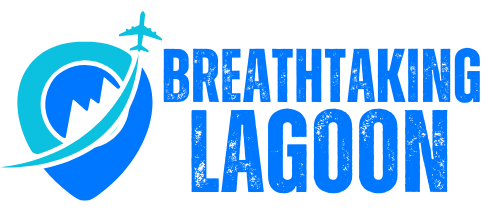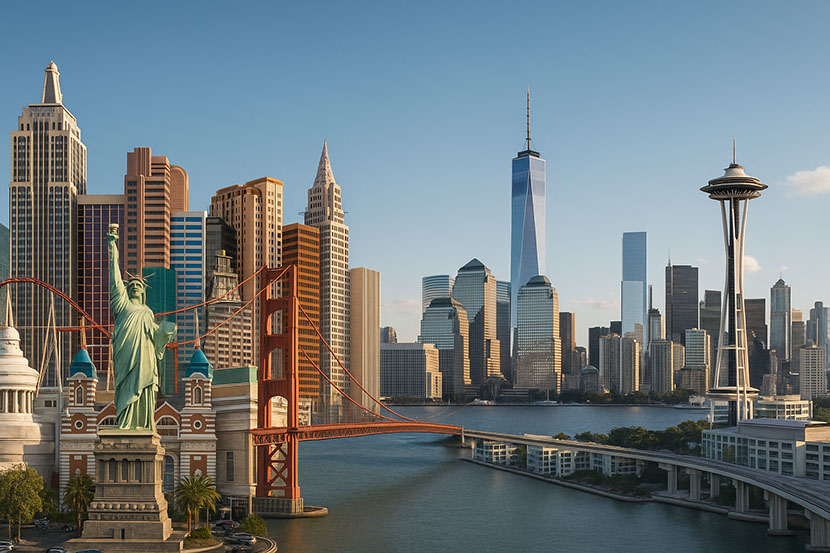Published on August 13, 2025
By: Tuhin Sarkar
Las Vegas has now joined the ranks of New York, San Francisco, Los Angeles, Miami, and Seattle as a major US tourism hub grappling with a worrying downturn in visitor numbers. Once bustling streets, crowded hotels, and packed entertainment venues are now seeing fewer travellers, and industry experts warn that this slump is beginning to ripple through the wider economy. The situation is not confined to one city—together, these destinations represent some of America’s most powerful tourism engines, and their slowdown carries national consequences.
One key factor behind this decline, analysts say, is the impact of new tariffs introduced under former President Donald Trump’s trade policies and Canada ditching America are the main reasons. These measures, aimed at protecting American industries, have also had the unintended effect of raising travel costs for many international visitors. Higher prices on goods, services, and flights have discouraged some tourists from making the trip, particularly from countries targeted by the tariffs.
Advertisement
Advertisement
For Las Vegas, where the economy depends heavily on conventions, entertainment, and leisure travel, the drop in international arrivals is especially concerning. Similar challenges are being felt in New York’s hotel districts, Miami’s cruise terminals, and Seattle’s waterfront attractions. Even San Francisco and Los Angeles, with their global brand appeal, are seeing softer demand in key foreign markets.
Tourism in the United States is facing a real test in 2025. Several famous cities report fewer foreign visitors and softer spending. Many local leaders point to Trump tariffs and tougher border rules as key reasons. In simple words, travel to the US feels harder and costlier for many people. This US tourism slump hurts bookings, hotel taxes, and city jobs. In this report, we explain what changed, how tariffs can cool demand, and which cities feel the squeeze. We also share clear steps that cities and travellers can take to steady the outlook.
Las Vegas Suffers a Weak Early Summer
Las Vegas is highly sensitive to changes in overseas demand. International visitors stay longer and spend more on shows and dining. A soft June and uneven July point to a slower year than expected. Local sources connect the slump to national forces that deter foreign trips: trade tensions, entry rules, and higher costs. When the top of the spending pyramid slows, the strip feels it quickly. A stronger push for off-peak deals and simple entry messages can help the city widen its funnel and rebuild momentum.
What Changed in the US Travel Landscape in 2025
Trade barriers rose in 2025. Analysts and business groups call these increases “Trump tariffs”. Some measures are broad and touch many goods. Others target certain countries or sectors. Tariffs push up prices across supply chains. They can also strengthen the US dollar. A strong dollar makes holidays in America feel expensive to visitors. At the same time, border checks, visa fees, and new screening rules add friction. When trips feel complex, some people choose other places. Together, these changes help to explain the US tourism slump now seen in gateway cities.
How US Tariffs Can Dampen International Visitors
Tariffs are not aimed at tourists. Yet they still shape travel. First, tariffs can raise costs for airlines, hotels, and shops. Higher costs may lead to higher prices for flights and rooms. Second, tariffs can move currencies. If the dollar rises, visitors’ money buys less in the US. Third, tariffs often come with noisy politics. News of trade fights can put people off leisure trips. Visitors like easy travel and friendly stories. When the mood turns negative, they delay plans. These simple effects help explain weaker city travel forecasts in 2025.
The National Trend Shows Softer Inbound Demand
The national picture shows headwinds for overseas travel to the US this year. Industry trackers and booking platforms report slower growth in long-haul demand. Tour brands say queue times at the border remain a concern. Some months show year-over-year dips in overseas arrivals. Domestic leisure demand still helps many places, but it cannot fully replace foreign spend in big cities. Long-haul guests stay longer and spend more per day. When they pause trips, hotel taxes and attraction revenue fall. That is why the US tourism slump feels sharp in major gateways.
New York City Lowers its Visitor Outlook
New York City is the bellwether for international travel. In 2025 the city cut its forecast for foreign visitors. Local briefings link the downgrade to tariffs, stricter entry checks, and a tougher global mood. Even a small fall in overseas guests has a big impact in New York. These visitors book longer stays, higher-rated rooms, and premium shows. When demand dips, it moves billions of dollars of city activity. The message from New York is clear. Smooth entry and friendly policy support matter if the city wants a full recovery.
California and Los Angeles see cooling demand
California is the top US destination for many foreign markets. Yet the state’s tourism outlook for 2025 turned lower. Forecasts point to a decline in international visits, with a sharper drop from long-haul Asia and parts of Europe. Los Angeles leaders warn that weaker inbound travel will weigh on hotel tax revenue. This matters as the region prepares for the FIFA World Cup and the Olympics. When travellers hear constant news about tariffs and tighter borders, some pick a different city or delay the trip. The cure is simple: an easy welcome.
San Francisco’s fragile comeback slows again
San Francisco was building back after hard pandemic years. But 2025 has been softer than hoped. Local reports call the slowdown a “Trump slump”. Sea-front businesses noticed quieter peak weeks. International segments remain below target, especially from China and parts of Europe. Tariffs and a strong dollar do not help. Visitors feel prices are high and the journey complex. The city still has strong assets: nature, food, culture, and innovation. Yet it needs clear signals of ease and value to bring back long-haul guests at scale.
Miami and Florida face softer foreign share
Florida still enjoys strong domestic travel. Beaches, theme parks, and cruise links keep hotels busy. Yet the share of international visitors is down in early 2025. Miami and other gateways report softer traffic from Latin America and Europe. Local media note that new national policies and trade fights have cooled demand from some key markets. For a state that profits from cross-border spend on shopping and dining, this change matters. Clear value messages, easy connections, and targeted promotions can protect the pipeline.
Seattle watches risks from Asia and trade
Seattle had a solid 2024. But 2025 brings new risks. Economic advisers warn of a likely drop in overnight international visitors. The region relies on Asia routes and a strong trade story. New tariffs add strain to trade flows and consumer confidence. If fewer long-haul guests arrive, downtown hotels and attractions will feel it fast. The fix is practical: keep air links strong, maintain visitor visas moving, and give clear, friendly border information. That helps the city stay top of mind in Asia.
The Canada effect on border markets
Canada is often the largest source of visitors to the United States. This year is different. Several outlets report a sharp drop in Canadian trips to the US, by air and by car. Commentators link the fall to tariffs, strong-dollar costs, and tense rhetoric. This change hurts border regions and big cities that market to Canadians. It also hits theme parks and outlet malls that rely on cross-border shopping. To respond, US destinations can run joint offers with hotels and retailers and set simple entry advice for day-trippers.
Cities most exposed to the tourism slump
Not all places feel the same pain. Some US cities rely far more on overseas business. New York, San Francisco, Los Angeles, Miami, Las Vegas, and Seattle sit high on that list. Their visitor base has more long-haul guests, who buy premium rooms and tours. When tariffs and entry friction cool mood or raise costs, these cities feel the shock first. Smaller cities that rely on domestic road trips feel less of a hit. The lesson is clear. Gateway cities need a sharper plan to defend international demand.
Other Forces Beyond Tariffs
Tariffs are a key backdrop in 2025, but they are not the only cause. Currency swings make the US pricier for some travellers. Visa backlogs and higher fees slow plans. Long border queues and strict checks make social media headlines. Airline strikes, higher fares, and tight capacity add to costs. All these pressures feed the US tourism slump. US Cities and states cannot change global cycles. But they can shape the welcome, the message, and the ease of entry. Those levers matter in every market.
Impact on city budgets and local jobs
Foreign guests punch above their weight in city finances. They fill higher-rated hotels, dine at premium restaurants, and shop for branded goods. When they stay away, hotel taxes and sales taxes soften. City travel forecasts in 2025 already show this shift. Marketing budgets then face cuts, and the cycle can worsen. Jobs in hotels, tours, museums, and retail also feel the strain. A clear plan to stabilise inbound demand is an economic policy, not just a travel tactic. It protects pay cheques and community services.
What travellers can do to save their trip
Travellers can still enjoy America with smart planning. Check visa rules and entry guidance early. Book flights and rooms with flexible terms. Consider shoulder seasons for better prices in big cities. Use official tourism sites for safe areas, events, and savings. If your currency is weak, prepay some items to lock costs. Fly early in the day to reduce disruption risk. Keep copies of bookings handy at the border. These simple steps cut stress and keep the focus on fun, food, and culture.
What tourism boards can do right now
Tourism boards should keep the message simple: easy entry, clear value, and safety. Work with airlines to protect key routes and add off-peak capacity. Speed up airport welcome with better signs and multilingual staff. Partner with museums, sports clubs, and venues to build themed packages. Target segments that still travel, like students, sports fans, and family visits. Share honest, friendly content about what is open, affordable, and close to transit. Data shows that smooth arrival and helpful information lift conversion.
How hotels, attractions, and retailers can respond
Hotels can offer free changes, longer booking windows, and bundle deals with transit and food. Attractions can add timed entry with value passes to make planning easy. Retailers can promote tax-free periods, currency-friendly pricing, and click-and-collect for travellers. Tour operators can build “no-surprise” packages that include transfers, tips, and entry fees. Clear value reduces price shock from currency moves and tariffs. When visitors feel looked after, they book and share. That word of mouth helps the whole city.
Outlook for 2026 and the big events ahead
The United States hosts the FIFA World Cup in 2026 and the Los Angeles Olympics in 2028. These events can flip the mood if the welcome is easy. Cities that fix the basics now will gain first. That means reliable visas, smoother borders, simple messages, and good prices for off-peak nights. If trade tensions cool and airlines add capacity, long-haul demand can rebound. With the right steps, today’s US tourism slump can turn into tomorrow’s strong recovery.
Tourism slumps in 2025 are most visible in US cities that rely on international guests. New York City has lowered its foreign visitor outlook. California and Los Angeles report cooling demand. San Francisco faces a fragile comeback. Las Vegas felt a weak early summer. Miami shows a softer international share. Seattle watches Asia-linked risks. Trump tariffs are not the only driver, but they play a clear role by lifting costs, strengthening the dollar, and clouding sentiment. Cities cannot change global policy alone. But they can make travel easy, clear, and good value. Do that well, and visitors will return in force.
Advertisement
Advertisement
Tags: Las Vegas tourism, tourism slump, Trump tariffs, US travel economy
I want to receive travel news and trade event update from Travel And Tour World. I have read Travel And Tour World’sPrivacy Notice.
Friday, August 15, 2025
Thursday, August 14, 2025
Friday, August 15, 2025
Thursday, August 14, 2025
Thursday, August 14, 2025
Thursday, August 14, 2025
Thursday, August 14, 2025
Thursday, August 14, 2025




